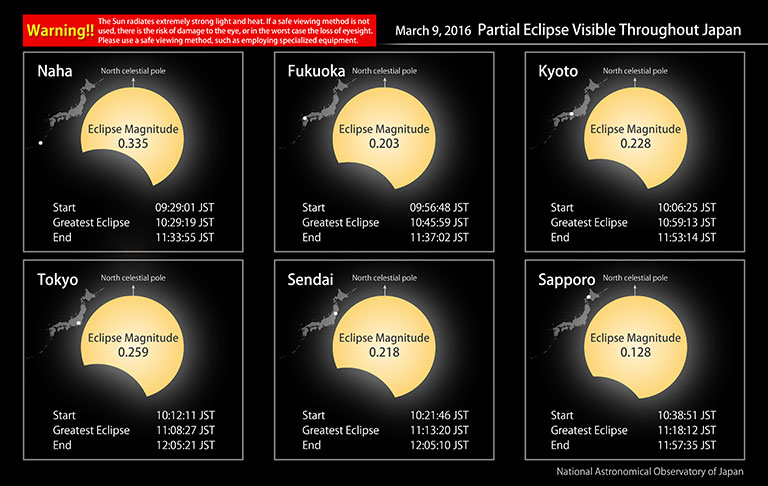Partial Solar Eclipse on March 9, 2016
| Topics

On March 9, 2016, a partial solar eclipse can be observed throughout Japan.
A solar eclipse is a phenomenon where part of the Sun seems to disappear as it is hidden by the Moon. This time, a total solar eclipse is visible from parts of South-East Asia around Indonesia, and from Japan a partial eclipse can be observed. This is the first solar eclipse visible from (the inhabited parts of) Japan in almost 4 years since the annular solar eclipse on May 21, 2012.
In Japan, the fraction of the solar disk hidden by the Moon at the time of greatest eclipse is about 22% in Naha, 15% in Tokyo, and 5% in Sapporo. The percentage increases the farther South-East the observation site is located.
As seen from Tokyo, the solar eclipse begins when the Moon starts to hide the Sun at 10:12 a.m.; the eclipse reaches its greatest extent at 11:08 a.m.; and the eclipse ends at 12:05 p.m. Please refer to the NAOJ Ephemeris Computation Office's “Local Prediction of the Solar Eclipse” for detailed forecasts for each area.
For Japan, the percentage of the solar disk hidden during this partial eclipse is not large, but it is possible to observe the entire solar eclipse from start to finish. When observing a solar eclipse, please use safe viewing methods, such as employing specialized solar eclipse viewing equipment. Even if you use an eclipse viewer, please follow the instructions and keep the time spent observing the Sun short. DO NOT LOOK DIRECTLY AT THE SUN WITH THE NAKED EYE, even during a solar eclipse.
The next solar eclipse visible from Japan is a partial solar eclipse on January 6, 2019. It is observable throughout Japan.